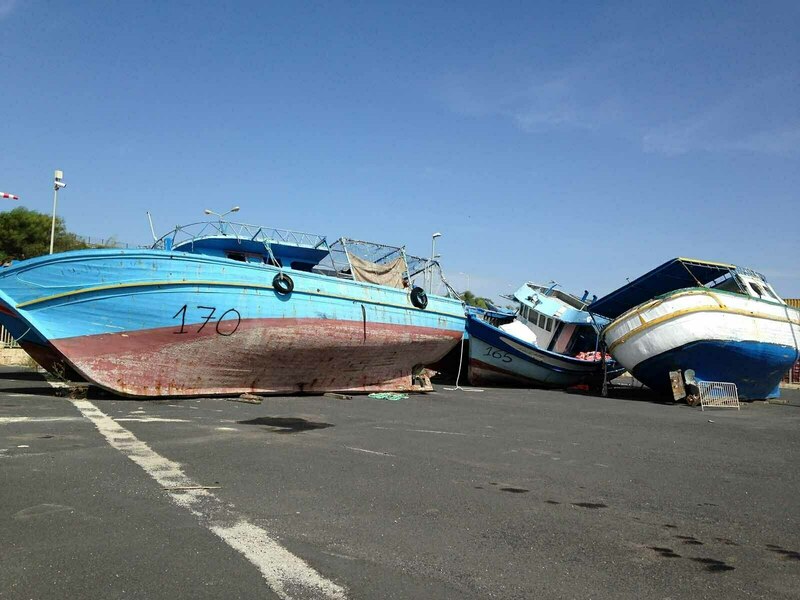
Nero Sangue
Binta Diaw
The Fruit of Migrant Labor: Binta Diaw and the Fight for Migrant Rights in Italy
By: Kendra Lyimo ’24
In October 2020, the Museo Arte Gallarate launched The Recovery Plan, which sought to spotlight artists of African descent in Italy. Five exhibitions featuring five different artists were presented consecutively in the cultural center. One of these artists was Binta Diaw whose solo exhibition was titled “Nero Sangue” Diaw’s evocative installation sought to center perspectives from the African Diaspora with particular attention to the displacement, dehumanization, and exploitation that impacts the experiences of Black Italians.
Binta Diaw_YGBI Research Residency 02/2020 from BHMF and the Recovery Plan on Vimeo.
Senegalese-Italian artist Binta Diaw was born in Milan, Italy in 1995. She was raised by two parents with migrant backgrounds and currently lives and works between Milan and Dakar, Senegal. Diaw emphasizes that migration has always felt like a beginning point for her art. This ode to migration and its role in human society also sits at the center of “Nero Sangue.”
“Nero Sangue” displays the economic exploitation of Blackness through a threefold installation. At the center are two tomatoes on a vine, displayed atop a white pedestal. By placing the delicately perched fruits on the pedestal, Diaw monumentalizes the produce that holds deep significance in Italian culture. However, having lost their red color and visual ripeness, the tomatoes instead possess a black sheen that is accentuated by a natural green, perfectly preserved stem.
On the walls of the gallery are small pieces of cotton with images of the Black individuals “immersed in vegetation” as described by Italian scholar Angelica Pesarini. These small yet striking images are taken from colonial and fascist propaganda that dehumanized Black individuals by relating them to nature and distancing them from Italy’s technological and cultural progress. The thin sheets of cotton flutter with the passing breeze, evoking a ghostly presence. Though the images are a memory of the past, their presence haunts Italy’s present.
The final component of the installation is a pile of tomatoes covered in black paint stacked daringly in the corner of the room. One lone fruit sits apart from the rest as though it were crawling to reach the viewer. The fragile fruit makes viewers hesitant to venture closer while its dark skin highlights its irregularities. The unfamiliar color of the tomatoes prompts viewers to wonder what caused them to turn black.
However, Diaw insists that the question is not what turned these tomatoes black but rather who. The title, “Nero Sangue” or “Black blood,” functions as Diaw’s subject. These esteemed tomatoes, planted and harvested by Black migrants, lose their bright red hue and take on the color of the bodies whose blood is spilled for their maturation.

Members of the SOS Mediterranean ship MS Aquarius rescue migrants on a small craft in the Mediterranean Sea, July 29, 2016. Released by U.S. Navy in Mass Communication.
In Italy, the principle of jure sanguinis dictates one’s eligibility to gain Italian citizenship by blood, while simultaneously excluding migrants and those born in Italy to migrant parents from becoming citizens. Migrants’ ineligibility to obtain citizenship by right of blood forces them to pursue a more protracted, uncertain process, leaving them without protection and in danger of exploitation. One of these exploitative phenomena is caporalato, an illegal labor contracting system that allows contractors to take advantage of migrant workers who must obtain work to claim legal status. Prominent in the production of tomatoes in Italy, caporalato refuses its laborers health care, safe and plentiful drinking water, and quality lodging. Diaw calls out these horrific conditions, which have resulted in the death of many migrants. “Nero Sangue” becomes a monument to the individuals whose lives and labor contribute to the country’s economic and agricultural growth.

Memorial in Pozzallo pays tribute to those who died trying to cross the Mediterranean Sea from North Africa. Photo by Nicolas Pinault, voanews.com, 2013. Public Domain.
While some lose their lives on account of unfit working conditions, others lose them before they even reach Italy—like the migrants who arrive on boats, only to be prevented by law from rescue and met by the sea’s encompassing waves. It appears that even the Mediterranean Sea has Black blood mixing with its murky waters, uniting the solemn deaths of the courageous migrants who sought opportunity with the memory of the enslaved who may have crossed the same waters. In this way, Diaw’s evocative installation calls upon these carefully forgotten legacies. She uses tomatoes—a fruit that is non-native to Italy—to remind viewers to consider how cultural identities are constructed and whose stories are erased. She places the stories of Afro-Italians on the floor, on a pedestal, and along the walls to prevent viewers from averting their eyes. However, Diaw only surrounds the tomatoes and the cotton photographs with empty space. Viewers come face-to-face with the overwhelming sparsity of the exhibition, which evokes the painful histories purposely left out of Italy’s national story. “Nero Sangue” is inherently confrontational and meant to make Italy reckon with a difficult history it is all too inclined to forget.

Kendra Lyimo is a senior at the University of Notre Dame majoring in art history with minors in Africana studies and Italian. During her time as an undergraduate student at Notre Dame, Kendra has worked as a gallery teacher and research assistant at the Raclin Murphy Museum of Art, a scientific guest at the Bibliotheca Hertziana in Rome, and an undergraduate research fellow at the Notre Dame Institute for Advanced Study. Following graduation, she will spend two years in the United Kingdom as a recipient of the Marshall Scholarship, where she will pursue an M.A. in the history of design at the Royal College of Art followed by an M.A. in African studies at SOAS University of London.
Research by: Kendra Lyimo
Art by: Binta Diaw
Theme: Decolonization
Header image: Workers picking strawberries. USDA Photo by Lance Cheung. FSA. Public Domain.

Arkhticós Doloros
Art by Jessie Kleemann, research by Erin Tutaj